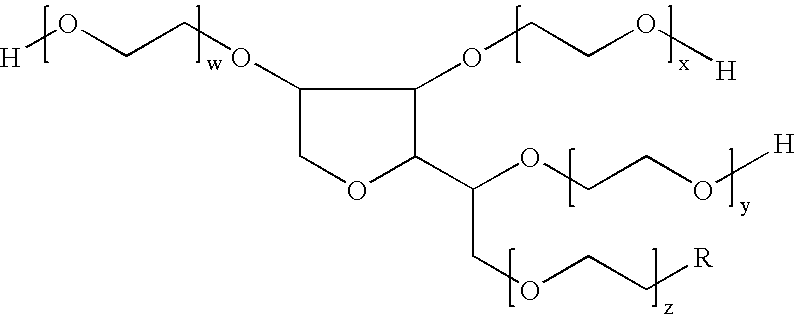Fluoropolymer dispersion containing no or little low molecular weight fluorinated surfactant
a fluorinated surfactant and fluoropolymer technology, applied in the field of aqueous fluoropolymer dispersions, can solve the problems of low molecular weight fluorinated compounds raising environmental concerns, increasing viscosity, and affecting the stability of upconcentrated dispersions, so as to achieve low viscosity and less susceptible to discoloration
- Summary
- Abstract
- Description
- Claims
- Application Information
AI Technical Summary
Benefits of technology
Problems solved by technology
Method used
Image
Examples
example 1
A fluoropolymer dispersion of PTFE with a particle size of about 220 nm and having a solids content of 25% by weight was obtained from an emulsion polymerization. To the dispersion were added 5% by weight of Genapol™ X-080 based on the amount of solids in the dispersion. The dispersion contained about 0.1% by weight of APFOA based on total weight of the dispersion (=4350 ppm based on polymer solids). The emulsion polymer was contacted with an anion exchange resin so as to reduce the amount of APFOA in the dispersion to 7 ppm based on total weight of the dispersion (=30 ppm based on polymer solids). The dispersion was upconcentrated through ultrafiltration to an amount of PTFE solids of 60% by weight. 2000 ppm of A16 surfactant were added based on amount of solids and the amount of Genapol™ X-080 was adjusted to 5% by weight based on solids to account for loss of this surfactant in the upconcentration. The resulting dispersion had a viscosity of 22 mPa, a VTT of 28° C., a surface ten...
examples 2 to 14
In examples 2 to 14, the same procedure as outlined in example 1 was repeated, but Genapol™ X-080 was replaced by surfactants or mixtures of surfactants as given in table 1. Examples 2 to 10 were made with 2000 ppm A16 as non-fluorinated anionic surfactant; examples 11 to 14 were made with 400 ppm Hostapur™ SAS 30 as non-fluorinated anionic surfactant. For all the emulsions, the viscosity, VTT, surface tension and CFT were measured. All of the emulsions had a VTT of at least 28. The results are given in table 1. Also recorded in table 1 are the HLB values of the surfactant mixtures.
PUM
| Property | Measurement | Unit |
|---|---|---|
| Viscosity Transition Temperature | aaaaa | aaaaa |
| particle size | aaaaa | aaaaa |
| cloud point | aaaaa | aaaaa |
Abstract
Description
Claims
Application Information
 Login to View More
Login to View More - R&D
- Intellectual Property
- Life Sciences
- Materials
- Tech Scout
- Unparalleled Data Quality
- Higher Quality Content
- 60% Fewer Hallucinations
Browse by: Latest US Patents, China's latest patents, Technical Efficacy Thesaurus, Application Domain, Technology Topic, Popular Technical Reports.
© 2025 PatSnap. All rights reserved.Legal|Privacy policy|Modern Slavery Act Transparency Statement|Sitemap|About US| Contact US: help@patsnap.com


